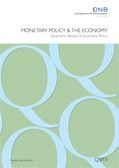Monetary Policy and the Economy Q3/14
 OeNB
OeNB
- published:
- September 2014.
 OeNB
OeNB
Monetary Policy and the Economy Q3/14 (PDF, 3 MB) September 2014.
Austrian GDP Growth at 0.8% in 2014 (PDF, 410 kB) Fenz. Fenz – Monetary Policy and the Economy Q3/14 en Sep 30, 2014, 12:00:00 AM
Labor Productivity Developments in Austria in an International Perspective (PDF, 1.6 MB) Schneider. Schneider – Monetary Policy and the Economy Q3/14 After World War II, Austria, like other European countries, had for decades been improving its labor productivity, continuously catching up relative to the United States. Only then U.S. labor productivity grew at an accelerated pace from the mid-1990s to the mid-2000s on the back of new technologies implemented in distribution as well as finance and business services, did Austria – and in particular its service sector – fall behind. Unlike the U.S.A., Austria did not benefit from a technology-driven boom. By contrast, the productivity performance of Austrian manufacturing, without the production of information and communications technologies, is comparable to that in the U.S.A. and in Germany. Hence, to boost labor productivity in Austria, a high priority should be given to policies stimulating the diffusion of new technologies in the service sector. en Labor productivity, growth accounting, services, information and communications technologies O30, O47, O57 Nov 4, 2014, 12:00:00 AM
How Gender-Specific Are Payments? A Study Based on Austrian Survey Data from 1996 to 2011
(PDF, 452 kB)
Forstner, Wagner.
Forstner, Wagner – Monetary Policy and the Economy Q3/14
Based on payments surveys commissioned by the OeNB in 1996, 2000, 2005 and 2011, this study highlights patterns in consumer payment behavior in Austria with a view to establishing
gender-specific patterns and changes thereof. While cash continues to dominate, we find that its use contracted to a share of roughly two-thirds in value terms in the review period. This decline was almost twice as large for women as for men (–24 percentage points versus –12 percentage points), thus more than offsetting the significantly higher cash payment volume of women observed in 1996 (90% versus 81%). By 2011, women were heavier users of debit cards than men, in terms of transactions as well as in terms of value.
The higher tendency of women to use cashless payment systems evidently reflects safety concerns with cash. Women are also more risk averse than men in the sense that they are
more likely to plan their monthly expenses and more likely to acknowledge the relevance of keeping an eye on what they spend.
en
E58, E41, D12, J16
Nov 4, 2014, 12:00:00 AM
Austria Holds Intra-EU Export Market Shares almost Constant despite Difficult Economic Environment
(PDF, 824 kB)
Vondra.
Vondra – Monetary Policy and the Economy Q3/14
Before the global recession, export growth outperformed economic growth across the EU. The economic crisis hit almost all EU countries through a steep fall in exports, especially exports of goods. Yet, as shown in this article, almost all countries in Europe were hit by the slump in exports simultaneously; hence, intra-EU export market shares were left broadly unchanged by the crisis. This article presents a market share analysis for both goods and services and explores some underlying factors for these developments. From a regional perspective, Central, Eastern and Southeastern European (CESEE) countries gained market shares in the period 2004 to 2012 at the expense of major pre-2004 EU countries (the U.K., France and Italy).
From a product perspective, service market shares developed broadly in line with goods market shares. At the same time, service-oriented countries were able to compensate losses in goods market shares by expanding service market shares. Austria managed to keep its market share position almost constant, benefiting most from trade links with Germany. At the product level, Austria strengthened its exports of high-technology good products.
en
F14, F15, F40
Nov 4, 2014, 12:00:00 AM